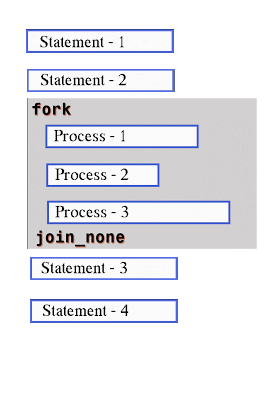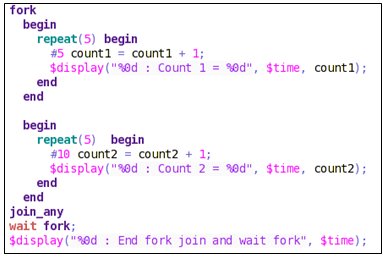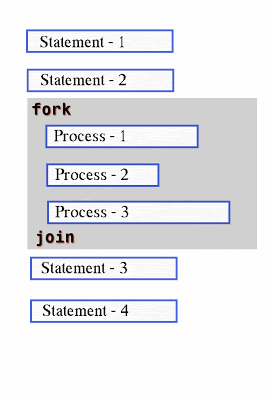Explain Difference Between Fork Join Fork Join_none and Fork Join_any
The spawned processes do not start executing until the parent thread executes a blocking statement. As in the case of Fork-Join and Fork-Join_any fork block is blocking but in case of Fork-Join_none fork block will be non-blocking.

Systemverilog Fork Join None Verification Guide
This is a simulation artifact.

. It is worth noting here that various threads that are responsible for the completion of the sub-tasks never sit idle. In parallel computing the forkjoin model is a way of setting up and executing parallel programs such that execution branches off in parallel at designated points in the program to join at a subsequent point and resume sequential execution. Here Sum is a subclass of RecursiveTask and leftfork spilts the task into sub-tasks.
Because forkjoin is a blocking statement only the statements in forkjoin are executed in parallel. Maitreya Staff asked 1 year ago. Joins and forks should balance meaning that the number of flows that leave a fork should match the number of flows that enter its corresponding joinThe activity Stream audio needed to tell the activity Synch mouth when important pauses and intonations occurred.
Fork is a process in which a task splits itself into smaller and independent sub-tasks which can be executed concurrently. Answer 1 of 2. The forkjoin pair causes all statements inside to be executed in parallel.
A fork and join. Forkjoin can be considered a parallel design pattern. The join instruction is the that instruction in the process execution that provides the medium to recombine two concurrent computations into a single one.
There is a third type of fork join in SystemVerilog which is fork and join_none. If there are other earlier fork_join_none statements that do not need to. Fork pseudostates split an incoming Transition into two or more Transitions terminating in Vertices in orthogonal Regions of a Composite State.
A fork and join_none will allow the main thread to resume execution of further statements that lie after the fork regardless of whether the forked threads finish. Fork and join are one pattern of parallel computing. Below I mainly explain the difference between fork_join and fork_join_none.
If five threads are launched the main thread will resume execution immediately while all the five threads remain running in the background. This will block the current thread until all child threads are completed. Also the wait_fork has to be outside the fork-join_xxx statement.
In the above example wait fork will wait for the rest of the active threads to be finish in the fork-join_any. The forkjoin_any blocks until any of the spawned processes completes. Alternatively you can use separate fork and join methods.
It is done sequentially as well but in the delayed scheduling region. View Verilog lab 4docx from ECE 325 at Manipal University. SystemVerilog also provides a variation to the original with a fork and join_any.
The forkjoin_none is non-blocking so all forked processes start at the same time as the code following the forkjoin_none. The join method allows ForkJoinTask to wait for completion of another ForkJoinTask. What we need to do is to add a wait_fork statement after the for loop.
In the below example fork block will be blocked until the completion of any of the Process Process-1 or Process-2. Fork Join None The parent process continues to execute concurrently with all the processes spawned by the fork. The fork method submits a task to a pool but it doesnt trigger its execution.
The Transitions outgoing from a Fork pseudostate cannot have a guard or a trigger and the Effect behaviors of the individual outgoing Transitions are at least conceptually. In your fork-join example the wait fork is not required. For RecursiveTask it returns the result of the tasks execution.
You can only pass join when all inputs are incoming. What is the difference between forkjoins forkjoin_none forkjoin_any. Now suppose you have exited the fork block by join_none or join_any and after some statements or after some simulation time you want to kill all the active threads by the previous fork block.
SystemVerilog Fork Join none. The fork is responsible for splitting the task and join is responsible for merging the results of the task to generate the final result. 0 Vote Up Vote Down.
The fork systems call assignment has one parameter ie. The fork helps ForkJoinTask to be planned and also allows launching a new ForkJoinTask from the existing one. Explain the difference between fork-join forkjoin_none and fork- join_any.
What do you believe an executive assistant brings to a. There are two methods defined in the ForkJoinTask one is fork and other is join. You can perfectly model the states between fork and join by doing a Cartesian product between and then.
Parallel sections may fork recursively until a certain task granularity is reached. With the addition of the join_any and join_none keywords SystemVerilog provides three choices for specifying when the parent forking process resumes execution. Join is a process in which a task join all the results of sub-tasks once the subtasks have finished executing.
The join method must be used for this purpose. The difference between blocking and non-blocking assignments is when the value gets assigned to a left hand side variable. Both Process-1 and Process-2 will start at the same time Process-1 will finish at 5ns and Process-2 will finish at 20ns.
This means the fork will hang the simulation if any of the child threads run forever and never complete. They belong to test-bench. Syntax Sum left new Sumarray low mid.
In SystemVerilog you can use fork - join_none or join_any then you can use wait fork after the join_xxx statement to wait for all the threads in the fork-join_xxx to complete. The join instruction has one parameter integer count that specifies the number of computations which are to be joined. VE Full Access 108 posts.
There is one thing you are missing with regard to join. Think of it like a fork in the road. That cannot be modeled simply by more incoming connections.
Some cars will go one way some will go another To join is to wait for split-off tasks to finish and resume a single thread of operation. In the case of RecursiveAction the join returns nothing but null. To fork is to split off a task.
Fork-Join_any will be unblocked after the completion of any of the Processes. Non-blocking assignment cause delayed assignment. ExecutorService is an Executor that provides methods to manage the progress-tracking and termination of asynchronous tasks.
SystemVerilog Fork Join any fork join any example. In the above example there are two forks and two joins. Fork creates more active states that can then propagate independently.
Processes inside the fork-join_none block will be started at the same time fork block will not wait for the completion of the Process inside the fork-join_none. The ForkJoin framework in Java 7 is an implementation of the Divide and Conquer algorithm in which a central ForkJoinPool executes branching ForkJoinTasks. In a simple SystemVerilog fork join the main thread waits until all the child threads have finished execution.

Implementing Parallel Processing And Fine Control In Design Verification

No comments for "Explain Difference Between Fork Join Fork Join_none and Fork Join_any"
Post a Comment